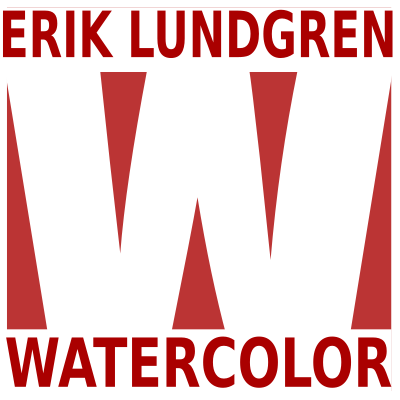Three primary colors

This exercise primarily develops your color mixing skills. You must use the three primary colors: red (cold red), yellow (preferably lemon yellow, but not necessary) and blue (preferably cold, phthalo or Prussian). I personally used Quinacridone Rose, Phthalo Blue (RS) and Nickel Dioxin Yellow PY153, (A yellow color that is unfortunately no longer available, but any bright yellow color will do.)
With these three colors it is possible to mix all possible colors. For most color mixtures in the painting, all three are needed, so there will be a lot of mixing. It is therefore an excellent color mixing exercise.

There is a lot of wet on wet in this painting. A bad paper will only make you disappointed with the result. Use a good cotton paper, an inferior paper will work very poorly for controlled wet on wet painting. I myself used Arches for this painting.
Step 1

Start painting the background. Just make a reasonably interesting pattern that doesn’t represent anything in particular. First, wet the entire background, around the apples (and stems) and the bowl, down to the plate on which the bowl stands. Then paint, using different color mixtures in the wet surface, so that all colors flow into each other. Use all three colors, but not individually, but mix them before placing them on the paper.
Step 2

Mix a gray-blue color to the surface on which the bowl stands. Make the mixture quite dark, but you don’t need a lot of it, a little is enough. When you’re happy with the mixture, take some of it and put it in an empty mixing cup. Then dilute this with so much water that almost no color remains. Paint with this very light color the entire surface under the bowl, and then, before the liquid has dried, paint a shadow with the original color mixture wet on wet.
Step 3

The bowl looks like frosted glass, this step is to try to imitate it. (Actually it’s just a plastic bowl from IKEA but in the photo it looks like a nice Finnish glass bowl.)
Start by making the following mixtures: a yellow-orange (yellow + red), a warm red (red + a little yellow) and a grey-black (all three). Make these various mixtures quite dark, they will lighten quite a bit when they are later placed on a wet surface.
First, paint the entire front of the bowl (leave the inside unpainted) with just water. Let the water soak into the paper for a bit before you start painting. Now, create a rough shape of the apples by dabbing the paint into place. Avoid using brush strokes; instead, try to lightly touch the paper with the brush tip, loaded with paint. A drop will spread across the paper surface; repeat this type of painting over the entire area with the different color mixtures. Also, use just plain water to “push” back the paint that has spread too much. You can continue dabbing until the paper is almost dry.
When the front of the bowl is dry, paint the small “corners” of the inside of the bowl with a light gray color. Leave a narrow edge between the inside and outside of the bowl so that the bowl has a thickness. Allow the entire bowl to dry before finishing with the next step.
Step 4

I painted the apples in the following way: First I color an apple with a warm yellow color (yellow + possibly a little red), then, while the yellow color is still wet, I add a red color with brush strokes that follow the shape of the apple. The red color probably needs to be made a little darker so that the apples don’t become too colorful. Darken the red color by mixing in dark gray paint that you hopefully have left over from before, otherwise you’ll have to mix new. Try to create the shape of the apple through shadows and highlights.
When the first apple is dry, the next apple is painted in the same way, and then the third, as well as the small corner of a fourth apple. None of the apples should be painted right down to the front of the bowl, leave a small white border between the underside of the apples and the front of the bowl, otherwise the bowl will not have any thickness.
Avoid painting the stems of the apples, it never looks good to paint a dark color on top of a colored surface. Therefore, save the stems when you paint the red apples. Then, when the red paint is finished and dry, paint the dark stems, leaving a small highlight on the side of each stem. Otherwise it will easily become heavy and boring.













Rolig och vacker övning men ganska svår som kategorin antyder. En bra info vore också ungefärliga mått på papperet som du använt.
Den här bilden är ungefär 30X20 cm.